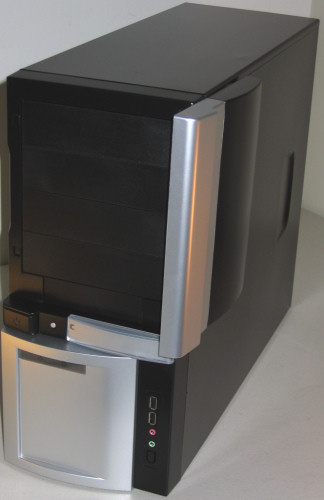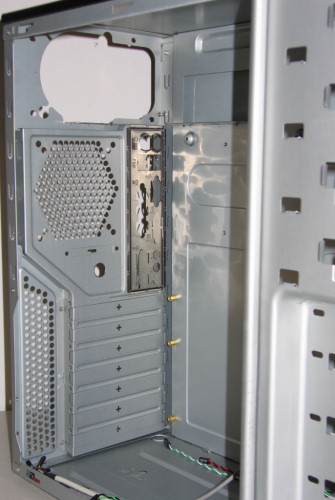Price-Point Comparing Three-Way Case Shootout
by Joshua Buss on January 13, 2006 12:05 AM EST- Posted in
- Cases/Cooling/PSUs
Dynapower E68 (cont’d)
The bezel doesn't just have the ability to slide at the bottom either; in addition to hinging to reveal the drive bays, the main portion (the top door) also slides along a couple of slits so that after opening, it can be further moved out of the way. While some people might consider such a dynamic front gaudy, it's still undeniable that it's a very nice front panel, especially given this unit's cost.
With all the attention that the front of this case has received, it's a good thing that the rest of the case is almost entirely devoid of anything that needs a lengthy explanation! This last picture of purely the exterior of the chassis really doesn't differ much from the other two cases that we've looked at all. Again, the side-mounted 120mm fan shows up, but besides that, there are no other elements of cooling to investigate here.
With that investigation over, let's dive into this value-oriented case. First off, as is probably to be expected, there are no tool-less elements in the E68. Also, we should mention that we actually routed the cables from the front through a different opening to help our cable management.
Even so, the actual expandability of the Dynapower case is just as good as the other two cases. Four hard drives, one external 3½“, and four external 5¼” drives can all be accommodated in the E68.
Support for different motherboard types is even more limited in this case, but again, the standard ATX types shouldn't be much of a problem, if at all.
Standard knock-out expansion card covers are the name of the game here, but unlike other incarnations, these won't sever an appendage when attempting to remove them. And considering the lack of tool-less options here, it's tough to beat the tried-and-true method of using a single screw to hold each add-in card in place.
Really, that's about all there is to the inside of the E68. With a steel construction, the case feels just as sturdy as the X1, and if one wants, they can add another 120mm fan in the back and 80mm in the front. Installing our test bed was entirely void of surprises. The side-mounted IDE cable was neither easier nor harder than in the previous mid-towers.
The bezel doesn't just have the ability to slide at the bottom either; in addition to hinging to reveal the drive bays, the main portion (the top door) also slides along a couple of slits so that after opening, it can be further moved out of the way. While some people might consider such a dynamic front gaudy, it's still undeniable that it's a very nice front panel, especially given this unit's cost.
With all the attention that the front of this case has received, it's a good thing that the rest of the case is almost entirely devoid of anything that needs a lengthy explanation! This last picture of purely the exterior of the chassis really doesn't differ much from the other two cases that we've looked at all. Again, the side-mounted 120mm fan shows up, but besides that, there are no other elements of cooling to investigate here.
With that investigation over, let's dive into this value-oriented case. First off, as is probably to be expected, there are no tool-less elements in the E68. Also, we should mention that we actually routed the cables from the front through a different opening to help our cable management.
Even so, the actual expandability of the Dynapower case is just as good as the other two cases. Four hard drives, one external 3½“, and four external 5¼” drives can all be accommodated in the E68.
Support for different motherboard types is even more limited in this case, but again, the standard ATX types shouldn't be much of a problem, if at all.
Standard knock-out expansion card covers are the name of the game here, but unlike other incarnations, these won't sever an appendage when attempting to remove them. And considering the lack of tool-less options here, it's tough to beat the tried-and-true method of using a single screw to hold each add-in card in place.
Really, that's about all there is to the inside of the E68. With a steel construction, the case feels just as sturdy as the X1, and if one wants, they can add another 120mm fan in the back and 80mm in the front. Installing our test bed was entirely void of surprises. The side-mounted IDE cable was neither easier nor harder than in the previous mid-towers.
















69 Comments
View All Comments
bobbyto34 - Tuesday, January 17, 2006 - link
Silentpcreview is the first website that posted a review on the P150 (nearly 2 months ago). They got it long before the case was available in stores. Perhaps is it also because the guy from spreview worked with antec on the p180 (that's what they said in their P180 review).Sure we can criticize this test of the PC 150 because they use stock cooler. But if it says that the antec tricool is cleary audible at minimum speed and that a 150$ case makes as much noise as a 40$ case + silent PSU...
I prefer to know the product that i'm buying, specially if it costs 150$....
GameManK - Sunday, January 15, 2006 - link
...I still think it's a little ridiculous to compare noise measurements when using a stock cooling 6600gt and a Thermaltake CPU cooler... and is there a fan on that DFI too?? yuck. And of course the PSU.. no offense to AT, but I'd like to see a silentpcreview.com review of it.This review didn't use the hard drive suspension in the P150, and though I did suspend my drives in my Sonata, I don't really know how much of a difference it actually makes (my maxtor hdd is also quiet, and i never tried hardmounting the wd); there is no way that this review could have shown the benefits of using the suspension, or even the silicon grommets, in the P150 over the hard mounting in the other cases because the test system used components that are significantly louder than (decent) hard drives.
JoshuaBuss - Monday, January 16, 2006 - link
Our stock 6600 GT cooler, thermaltake cpu cooler, and PSU were all hand picked for being exceptionally quiet... the grommets did an exceptional job of isolating the hard drives - perhaps seeking noises would've been a few fractions of a decibel less in the fully suspended mode, but it simply wasn't the issue when it came to the noise emanating from the P150.. the tri-speed fan was a great deal louder than our hard drive.BPB - Friday, January 13, 2006 - link
The Antec is $113.99 before shipping at http://www.newegg.com/Product/Product.asp?Item=N82...">Newegg right now. That's with the power supply. That seems pretty reasonable to me. Problem is, I don't need a power supply. I have the 450W already. Sell the power supply on eBay and the price could end up being around $50. I said could end up.BPB - Friday, January 13, 2006 - link
Oops! Forgot to mention that the $113.99 is after rebate. So it's $157.98 with shipping, $132.98 after rebate.Jynx980 - Friday, January 13, 2006 - link
Some of these comments are pretty harsh. Its a mini review comparing various price points and people seem to be expecting a lot more. Eleven pages for three cases seems more than adequate. One suggestion I have would be to make your user name the author name the same for the comments. The name 'Tamale' doesn't seem to have anything to do with the article and I only noticed it from the email association.Tamale - Friday, January 13, 2006 - link
I'm still working with the site administration team to get "Joshua Buss" as a registered login name.mindless1 - Friday, January 13, 2006 - link
Forgive me if I've overlooked it, but in the noise comparisons the Antec and Raidmax are comparable, BUT does the Raidmax have a comparable filtration system?That is a huge issue, as one who has used filters for years I can assure you that any filter remotely fine enough to be effective has a significant impedance to airflow and to have one case filtered better (or at all) that still achieves same noise levels is no small feat.
However, it's flawed. One can't design a case such that there's only passive intake and throw a filter on the front else it causes more air intake through the drives and port holes, accelerated dust accumulation in them and all the other seemingly minor gaps. Therefore, it's necessary to install the two front 92mm pusher fans and have them at high enough flow rate that the case has positive pressurization so filtered air is exahaust out the drives and gaps rather than sucked in. Those front fans will also signficantlly increase noise levels perceptible to the user, unfortunately, thuogh a bit of dense foam bonded to the front bezel (interior wall) will help.
It's not quite clear what kind of lighting was used to take the pictures, but it is disappointing that the two shades of white (plastic and paint) on the Antec didn't match up. IMO, two different shades of the same color (when off as much as in the picture) is even worse looking than if they had aimed for an entirely different color. Personally I hate glossy paint too, it never holds up as well and gets fingerprints on it.
overall, despite these things the Antec looks like a winner to me. In fact if I didn't know better I'd think they lifted a few ideas from various case mods I've posted over the years. Either way, I thought they were good ideas, they proved to be too, and I'd certainly want them on a case I bought instead of having to DIY.
Tamale - Friday, January 13, 2006 - link
Good observations... the lighting we use is chosen carefully so that it can bring out differences in materials somewhat moreso than normal.. that being said, the difference you're noticing in these pictures has been exaggerated and wouldn't be as noticable under normal lighting conditions. There still is a difference though, which is understandable since one surface is metal and the other is plastic, but I doubt you'll find the case unattractive. The finishes are very nice.bob4432 - Friday, January 13, 2006 - link
a maddog psu? that is the best you as a reviewer have laying around? give me a break, at least throw in a old antec one or something, maddog - isn't that compusa generic stuff?